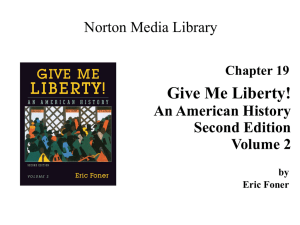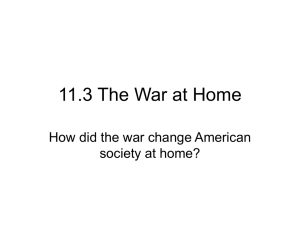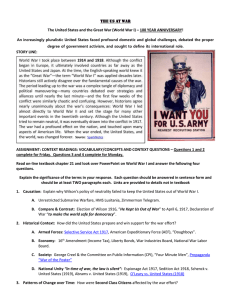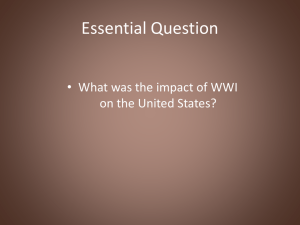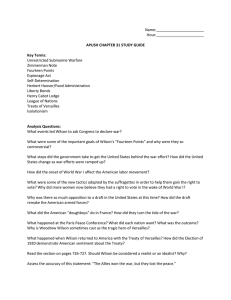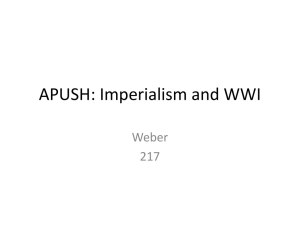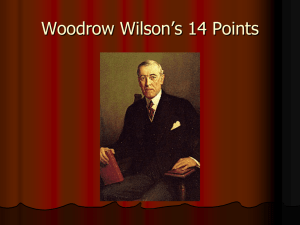APUSH: “Safe for Democracy” – The US and WWI
advertisement
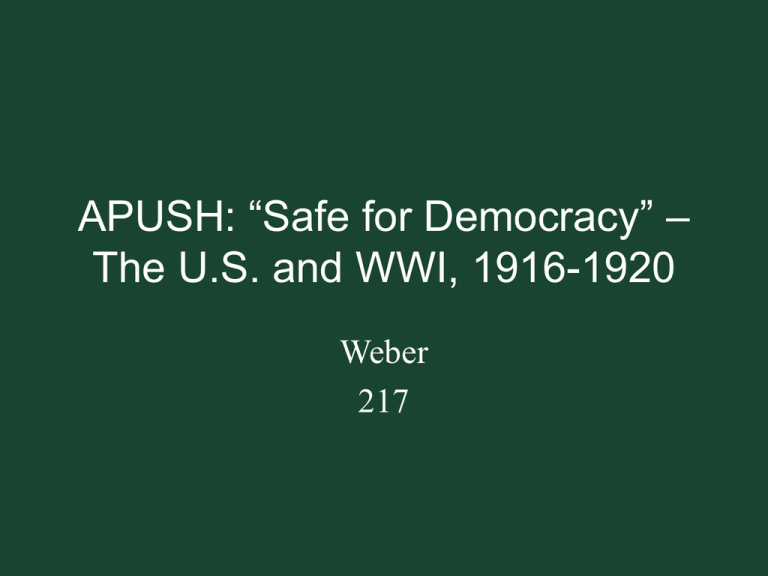
APUSH: “Safe for Democracy” – The U.S. and WWI, 1916-1920 Weber 217 Activator • Congratulations on finishing first semester! • You have accomplished a whole lot and have so much to be proud of. • The new semester is a completely fresh start. – 1. Reflecting on how you did first semester, what are you happiest about and what are you not so happy about? – 2. What is your goal for this semester? – 3. What specifics things can you do to accomplish this goal? – Remember to turn in your DBQ on the Progressives today. Agenda • Activator, agenda, and objective (10 minutes) • “Safe for Democracy” WWII overview (45-60 minutes) – I. An Era of Intervention • Comprehension check (5 minutes) – II. America and the Great War • Comprehension check (5 minutes) – III. The War At Home • Comprehension check (5 minutes) – IV. 1919 • Comprehension check (5 minutes) – V. Forging a New International Order • Exit ticket and homework Objective • AP Topic #18: “The Emergence of America as a World Power” – American imperialism: political and economic expansion – War in Europe and American neutrality – The First World War at home and abroad – Treaty of Versailles – Society and economy in the postwar years Focus Questions • What was the role of the Committee on Public Information (CPI) during the war and what admen (advertisers) were able to gain from the CPI? • What were some wartime examples of coercive patriotism and how did it operate? • In what ways did the U.S. intervene in world affairs, aside from WWI, in the first two decades of the 20th century? • What were the major arguments made by W.E.B. DuBois in furthering civil rights in America? • What were the major causes of the Red Scare? “Safe for Democracy” • • • • • • • • • • This chapter begins with Wilson’s concept of moral foreign policy of “liberal internationalism.” Wilson promised to bring the Progressive agenda to the world but fell short. This forced Americans once again to debate the true extend of liberty. The era of intervention refers to the foreign policy of Theodore Roosevelt and William Howard Taft. Wilson was originally neutral going into WWI but when pushed into war his 14 points outlined his vision that this war should make the world “safe for democracy.” At home, the war was sold to the public via the Committee on Public Information (CPI). War also made some try to create racial boundaries and define who was “American.” Race was studies through eugenics which fueled the anti-immigrant sentiment of the era. AntiGerman hysteria was high and German immigrants were forced to prove their loyalty. African Americans were asked to work in the defense industries and serve in the army but faced continued discrimination and violence. In 1919 there was a world-wide revolutionary upsurge. Labor unions were attacked during the Red Scare as dangerous and part of a communist conspiracy. Wilson’s dreams for peace were shattered as the US Senate refused to ratify the Treaty of Versailles. I. An era of intervention • Theodore Roosevelt and Roosevelt Corollary – Panama • U.S.-backed separation of Panama from Colombia • U.S. acquisition of Panama Canal Zone • Construction of Panama Canal – Dominican Republic – Cuba • William Howard Taft and Dollar Diplomacy – Nicaragua – Honduras – Dominican Republic U.S. Global Investments and Investments in Latin America Panama I. An era of intervention (cont’d) C.Woodrow Wilson and “moral imperialism” – Haiti – Dominican Republic – Mexico • Mexican Revolution under leadership of Francisco Madero • Assassination of Madero and outbreak of Civil War • Wilson dispatch of troops, skirmishes with Pancho Villa U.S. Interventions in Latin America 18981920 Theodore Roosevelt: Speak Softly but Carry a Big Stick Big Stick Diplomacy (below). Corollary to the Monroe Doctrine establishing U.S. intervention and international police power (right). Moral Diplomacy The U.S. should be the conscience of the world. Spread democracy. Promote peace. Comprehension Check • Write a brief summary in your own words. • Write 3-5 questions that this brought up that you hope to find answers to in the reading. II. America and the Great War • Outbreak of European war – Assassination of Archduke Franz Ferdinand – Allied Powers (Britain, France, Russia, Japan) versus Central Powers (Germany, AustriaHungary, Ottoman Empire) – Protracted, bloody stalemate • Implications of European war – Undermining of faith in human progress and reason – Indication of power of nationalism in modern world II. America and the Great War (cont’d) C.American Response – Mixed sentiments • Sympathy for Allied Powers – British roots – Association of Britain with democracy, Germany with tyranny • Opposition to Allied Powers, and/or U.S. involvement – German, Irish, Russian (anti-czarist) roots – Antiwar feminists, pacifists, social reformers II. America and the Great War (cont’d) C.American Response 2. The road to American involvement • • • • • • • • • • • Initial declaration of neutrality British and German blockades American business ties to Britain Sinking of Lusitania “Preparedness” policy German suspension of submarine warfare against neutrals Reelection of Wilson; “He Kept Us Out of War” German resumption of open submarine warfare Zimmerman Note First Russian Revolution (Menshevik); overthrow of czar American declaration of war against Germany II. America and the Great War (cont’d) D.From American to Armistice – Second Russian Revolution (Bolshevik) • Vladimir Lenin’s break with Allies • Withdrawal of Russia from war – Wilson’s Fourteen Points – Defeat of German advance; Allied counteroffensive – German surrender Comprehension Check • Write a summary in your own words. • Write 3-5 questions you have that you hope to answer when reading the chapter. III. The war at home • Perceived prospects for fulfillment of Progressive vision – Economic rationalization – Spirit of national unity and purpose – Social justice III. The war at home (cont’d) B.Expansion of federal powers – Military conscription – Economic intervention • Areas – – – – – War production (War Industries Board) National transportation (Railroad Administration) Coal and oil (Fuel Administration) Farming and food preparation (Food Administration) Labor relations (National War Labor Board) • Varied degrees of intervention – Coordination of overall war production (WIB) – Control of some sectors (coal, oil, labor relations) III. The war at home (cont’d) B.Expansion of federal powers 2. Economic intervention c. Partnership between business and government – Guaranteed profit – Suspension of anti-trust d.Labor-management-government cooperation – – – – Uninterrupted production Federal mediation Labor’s right to organize Improved wages and working conditions 3. Raising of revenue – Corporate and income tax increases – Liberty bonds III. The war at home (cont’d) C.Propaganda war – Widespread opposition to American entry • Industrial Workers of the World • Socialist party – Committee on Public Information; George Creel • Modes of propaganda – – – – – Pamhlets Posters Advertisements Motion pictures Four-Minute speeches • Themes – Social cooperation – Expanded democracy and freedom – Demonization of Germans III. The war at home (cont’d) D.Revitalization of Progressive causes – Women’s suffrage • Optimism that wartime patriotism will gain women the vote • Insistence that women should enjoy “democracy” at home – National Women’s party – Alice Paul • Support from Wilson • Postwar ratification of Nineteenth Amendment III. The war at home (cont’d) D.Revitalization of Progressive causes 2.Prohibition • Sources of support – – – – – Employers Urban reformers Women Anti-immigration Protestants Anti-Germans • Progress – Passage of state laws – Postwar ratification of Eighteenth Amendment III. The war at home (cont’d) E.Repression of dissent – Instruments • Federal government – Espionage Act – Sedition Act • State governments • Vigilante organizations – Themes • Definition of “patriotism” as support for government, war, economic status quo • Definition of “un-Americanism” as labor radicalism, opposition to war III. The war at home (cont’d) E.Repression of dissent 3.Means • Criminalization of dissent; conviction of Eugene V. Debs • Investigations of suspected dissidents • Mass arrests • Public harassment and intimidation • Suppression of labor protest • Terror 4.Minimal reaction from Progressives III. The war at home (cont’d) F.The “race problem” – Progressive-era conceptualization • Ethnic groups as “races” • Inbred “racial” characteristics • Racial diversity as threat to American civilization – Progressive solutions • Mainstream – “Americanization” – Eugenics • Insistence by some on respect for other cultures III. The war at home (cont’d) F. The “race problem” 3. Wartime Americanization • Government-sponsored • Pressure on immigrants to demonstrate patriotism • Suppression of German-American culture 4. Heightened interest in immigration restriction, eugenics G.Ambiguous status of groups neither black nor white – Mexicans in Southwest – Puerto Ricans – Asian Americans III. The war at home (cont’d) H.Status and response of African-Americans – Progressive era • Barriers to political rights, employment opportunity, consumer economy • Progressives’ indifference or aversion to black freedom – Activists – Intellectuals – Presidents III. The war at home (cont’d) H.Status and response of African-Americans – Progressive era c.W. E. B. Du Bois and revival of black protest – – – – – – Du Bois background The Souls of Black Folk Challenge to Booker T. Washington accommodationism “Talented tenth” Niagara movement National Association for the Advancement of Colored People III. The War at Home (cont’d) H.Status and response of African-Americans 2. World War I era • Optimism that wartime patriotism would gain blacks equal rights – “Close ranks” – Minimal gains • Great migration – Scale and direction – Motivations and aspirations – Disappointing realities • Anti-black violence, North and South • New spirit of militancy – Silent Protest Parade – Garveyism Comprehension Check • Write a summary in your own words. • Write 3-5 questions you have that you hope to answer when reading the chapter. IV. 1919 • Upheaval around world – Inspirations and manifestations • • • • • Russian Revolution Spread of communist-led governments General strikes Peasant movements Anti-colonial campaigns – Underlying aspirations • Socialism • “Industrial democracy” • National self-determination IV. 1919 (cont’d) • Upheaval around world 3. Counter-mobilization • Allied intervention in Soviet Union • Limits of Wilson’s internationalism 4. Receding of postwar radicalism around world B.Labor upheaval in America – Breadth and magnitude – Spirit and themes • Appropriation of wartime rhetoric of freedom and democracy • Social and ideological diversity IV. 1919 (cont’d) B.Labor upheaval in America 3. Leading instances • • • • Seattle general strike Boston police strike Coal strike Steel Strike 4. Anti-union mobilization • Employers • Government • Private organizations 5. Defeats of postwar strikes IV. 1919 (cont’d) B.Labor upheaval in America 6.Red Scare • Methods – Federal raids on officers of labor and radical organizations; Palmer Raids – Arrests – Deportations – Secret Files • Outcomes – Devastation of labor and radical organizations – Broad outrage over abuse of civil liberties Comprehension Check • Write a summary in your own words. • Write 3-5 questions you have that you hope to answer when reading the chapter. V. Forging of postwar international order • Wilson’s performance abroad – Rapturous reception in Paris – Hardheaded diplomacy at Versailles • Treaty of Versailles – Wilsonian elements • League of Nations • New sovereign nations in Europe – Harsher elements • French occupation of Saar basin and Rhineland • Restrictions on German military • Crippling reparations for Germany V. Forging of postwar international order (cont’d) B.Treaty of Versailles – Limits of national sovereignty • Denial of independence for French and British colonies • League of Nations “mandates” for former Ottoman lands • Reallotment of former German colonies C.Seeds of instability for twentieth-century world D.Wilsonian internationalism in postwar America – Short term setbacks • • • • League of Nations debate Wilson’s stroke, incapacity Senate rejection of Versailles treaty Eclipse of Progressivism; “return to normalcy” V. Forging of postwar international order (cont’d) D.Wilsonian internationalism in postwar America 2.Long-term legacy for American foreign policy • Blend of idealism and power politics • Appeals to democracy, open markets, global mission • Impulse for military intervention abroad Exit ticket and homework • Exit ticket – How useful do you find the overviews of the chapter? – If it was completely up to you, how would you design the 5 hours of instruction so that we comprehensively cover one chapter per week? • Tues (2 hours); Thurs (2 hours); Fri (1 hour) • Homework – Read Ch. 19 for the test on Thursday.
